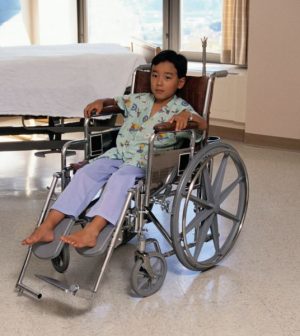- Skip Storing This Everyday Product in the Fridge Door
- Green Tea + B3 Pairing May Boost Brain Health
- Navigating Your Midlife Crisis: Embracing New Possibilities
- City Raccoons Showing Signs of Domestication
- Mapping the Exposome: Science Broadens Focus to Environmental Disease Triggers
- One Week Less on Social Media Linked to Better Mental Health
- Your Brain Changes in Stages as You Age, Study Finds
- Some Suicide Victims Show No Typical Warning Signs, Study Finds
- ByHeart Formula Faces Lawsuits After Babies Sickened With Botulism
- Switch to Vegan Diet Could Cut Your Greenhouse Gas Emissions in Half
Arthritis Can Strike Children

While arthritis is typically thought of as an older person’s disease, more than 300,000 American children have chronic juvenile idiopathic arthritis (JIA), an expert says.
Unlike age-related arthritis caused by cartilage and bone wear and tear, JIA has more to do with joint inflammation, but it’s not clear what triggers this inflammation, said Dr. Barbara Ostrov, a pediatric and adult rheumatologist at Penn State Health in Hershey, Pa.
Symptoms of JIA include joints that are consistently swollen, stiff or inflamed. In some cases, the disease also affects the eyes and can threaten vision if not diagnosed and treated promptly. All children with JIA should be monitored by an ophthalmologist.
The youngest children with JIA often don’t complain about their pain. Signs that they may have JIA include wanting to be carried for the first couple of hours a day due to morning stiffness, or a persistently swollen knee or limp.
“In many cases, children just work around the problem and do function with minor adjustments in how they use the affected joints. But the older kids tend to perceive their arthritis differently and may have more discomfort,” Ostrov said in a university news release.
For children with JIA who have inflammation in one or two joints, cortisone shots may offer relief for up to two years. Also, low doses of the medication methotrexate can help ease symptoms and inflammation in many patients.
If inflammation persists, doctors may prescribe biologic drugs to dampen an overactive immune response.
“We are fortunate to have medications to control this inflammation. Children tend to do well on them, with fewer side effects than adults,” Ostrov said.
The outlook for children with JIA is much better now than it was decades ago, she added.
“In the 1980s and 90s we had kids who needed hips, knees and other joints replaced with new joints. But now, having JIA is more about taking medication safely, monitoring symptoms and living well with arthritis,” Ostrov said.
More information
The U.S. National Institute of Arthritis and Musculoskeletal and Skin Diseases has more on juvenile arthritis.
Source: HealthDay
Copyright © 2025 HealthDay. All rights reserved.










